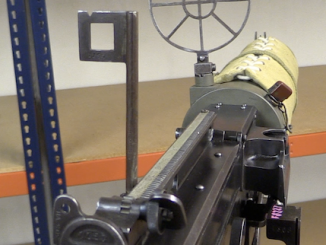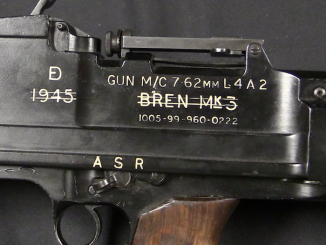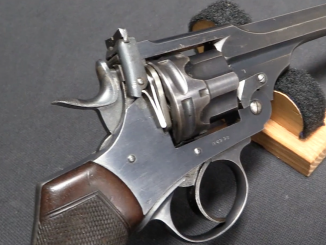As World War 2 exploded in Europe, rifle training suddenly because a very important topic in Great Britain. Typical solutions are small bore rimfire training variants of service rifles, but the British also wanted an option that could be used indoors and without any actual ammunition expenditure – and the Swift training rifle was the answer.
The Swift is a trainer the same size, weight, and balance as a Pattern 1914 Enfield rifle (and close enough to the No4 Enfield as to be quite usable). When “fired”, it projects a captive spring-loaded needle about an inch forward of the muzzle. It was coupled with a target from and paper targets depicting either plain silhouette targets or sketches of battlefields with enemy soldiers in various locations. The trainee would aim and fire, and the needle would prick a hole in the paper target at the simulated point of impact. In theory, this allowed for basic marksmanship training without noise, cost, or recoil.
The Swift trainers were well thought out, incorporating features like a spring loaded buttplate which would only allow the trigger to function if the rifle was pulled firmly into the shoulder. The mechanism was cocked by cycling the bolt, of course, but it specifically had to the cycled all the way back, to train shooters against short-stoking the mechanism. The force required to cycle the bolt forward was the same as that of a real rifle’s action, and the sight picture was also the same. In theory, it was an very good tool.
In practice, it was considered a joke by British soldiers and officers – much more useful for pranks played on companions bending over than for any sort of marksmanship training. The true potential of the device is probably somewhere in between the views of those officers and the Swift company designers.




“Swift trainers”
I found US patent: US2380296A
http://www.google.com/patents/US2380296
for DEVICE FOR USE IN ZEROING DUMMY RIFLES AND OTHER DUMMY FIREARMS USED FOR TRAINING MARKSMEN by Z. DE LUBICZ-BAKANOWSKI ET AL
Apparently Zygmunt Stanisław de Lubowicz-Bakanowski designed also automatic pistol for Swift Rifle Company – named Te-Tar
http://www.iwm.org.uk/collections/item/object/30032919
firing .32 Auto (7,65mm Browning) cartridge.
Which was also made by Webley & Scott in very limited numbers:
https://www.rockislandauction.com/detail/64/1431
aesthetic-wise is close to FN 1910 automatic pistol
And a bigger automatic pistol designed by Zygmunt Stanisław de Lubowicz-Bakanowski for Swift rifle company:
http://www.opisybroni.republika.pl/Tarn_eng.html
It was blow-back 9×19 design, rather uncommon join, but some example can be found, like Astra 600 of same era.
“The true potential of the device is probably somewhere in between the views of those officers and the Swift company designers.”
I think, when general concept might be viable, it is not worth of its price – why to waste production power for high-finish of training device, when real weapons are urgently needed?
If we talk about training device, I think air rifles used for military training are worth mentioning – for example Vzduchovka vz.35, see 1st photo from top here here:
http://www.vzduchovka.cz/detail/VZ35/Vz35_1.html
which was bolt-operated air gun used in Czechoslovakia
Photo explaining how it works:
http://www.vzduchovka.cz/detail/VZ35/Vz35_detail5a.html
There was also the Hollifield Dotter;
http://www.rifleman.org.uk/Hollifield_Dotter.htm
That could be used with any .30-06 chambered rifle. I believe it was made in .45 ACP for the 1911 pistol as well.
The Dotter was probably more practical than the Swift, as it did not require a specially-built “practice arm”.
cheers
eon
“did not require a specially-built “practice arm”.”
There were several inventions to allow fire low-power cartridge from full-power rifle, take for example that:
http://www.municion.org/5/5x9AustrianTreibpatrone.htm
Other example is German 4mm M20 cartridge, photos in municion:
http://www.municion.org/4m20/4m20.htm
clearly show how it is intended to work, however I presume that it would turn automatic pistol into repeating pistol, needing manual cycling after each shot.
However, now I found that there exist automatic pistol for 4mm M20: Erma ERP 74, see: https://www.youtube.com/watch?v=y7xx1ClQjc4
from my search that it seems (if I understand Czech language properly enough) that in Czech Republic weapons firing 4mm M20 are license free (can be freely bought) and called generally Flobertky (this category also include revolvers firing 4mm Flobert cartridge /small rim-fire cartridge/, hence its name)
However I hope Denny will deny or prove it and supply more precise data.
The cost of a rifle is a small fraction of the cost of the ammunition that would go through it during its lifetime, or even in a year of constant use as a trainer (100 rounds/day for 200 days is 20,000 rounds and at 10 cents each that is $2,000), so “sim-arms” do seem to have an economic argument for them. These days with electronics etc. one could even produce the sound of a gunshot inside the trainees’ earmuffs or through an external speaker.
Did you get the change to test the practicality of aiming at a slight angle down, and making a precision shot on a target which would react if nudged with the front of the barrel?
I feel like I’d want to tape down that buttplate-safety before using it for that purpose.
This concept is utilized by the US Army today, except instead of poking little holes in a paper target, you shoot at a projector screen with a faux-rifle that has a laser projector inside.
Currently the US Army is using the EST-2 , by Megitt Training systems.
Its a pretty slick system and it works very well for teaching the fundamentals of marksmanship without the requisite ammunition expenditure. Also coordinating range time is a huge pain in the ass.
The text-over suggests http://www.Rifleman.co.uk, but it should be http://www.Rifleman.org.uk
The EST is ok. They do simulate recoil, mag changes, etc, fairly well, but I’m not really sure how well they teach marksmanship. Personally, I usually shout 24-27 on the EST, but hit 30-35 at the range. Conversely, there’s a guy in my unit who Hawkeyes the EST, but generally only does in the mid 20s at the range.
When I was a kid, I remember playing with a very similar shooting gallery device in my German grandparent’s attic. It was a contraption made from stamped metal, with a P38-like pistol sitting atop, coupled to the frame like a joystick. In front of it was a mount for paper targets. Pulling the (very heavy) trigger apparently put a spring under tension, and when the trigger was fully backward, a needle pierced the target from behind, towards the pistol’s side. I guess this device was a toy and not a training aid, but I had a lot of fun with it.
OK, I’m late ro the party. Gunnery expert Sir Percy Scott developed the “Dotter” to improve his gunner’s marksmanship when captain of the Armored Cruiser HMS Terrible around 1900.
“The Dotter was a training device invented by Percy Scott c. 1900-02 to permit gunlayers to practice continuous aim and to measure their success, all without expending ammunition. It became one of the hallmarks of Scott’s transformation of Royal Navy gunnery and exemplified how his innovations were often syntheses of drill and equipment.
Its nature and its various configurations are outlined in Manual of Gunnery (Volume III) for His Majesty’s Fleet, 1915”
In the annual gunnery trials after he instituted use of the dotter, Scott insisted that officers be posted aboard Terrible to prevent any charges of cheating or “impossible!” She recorded the highest score in the history of the Royal Navy – by several orders of magnitude and initiated a revolution in naval gunnery.
(http://www.dreadnoughtproject.org/tfs/index.php/Dotter) (https://en.wikipedia.org/wiki/Percy_Scott#Gunnery_developments)
His equivalent in the USN (https://en.wikipedia.org/wiki/William_Sims#Gunnery)